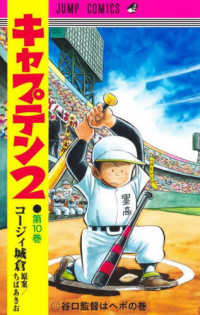- ホーム
- > 洋書
- > 英文書
- > Science / Mathematics
Full Description
Chief Anthony Avillo's bestselling Fireground Strategies is an invaluable resource for the education and development of outstanding fire officers, and this fourth edition builds upon the art of strategic firefighting by keeping on top of its ever-evolving information ecosystem. Through case studies and illustrative examples, Avillo covers how to identify a strategy, develop an action plan, and implement tactics to meet the objectives of the course of action on a fireground. Fireground Strategies is a required text in senior-level undergraduate firefighting strategies courses and is recommended reading for promotional exams across the United States.
Updates and Highlights for the Fourth Edition:
Expanded scene arrival protocols to better control an escalating fireground
The concept of the RIT assist team (RAT)
The concept of the RIT, after softening the structure, as an accountability team
Mutual aid considerations for an escalating incident
An analysis of the differences between exterior and interior size-up
Expanded concepts on heat transfer and the modern fire environment
Expanded and updated building construction chapter, including combustible cladding, mass timber, pedestal construction, engineered wood frame, OSB, and T-stud framing
Use of exterior and interior control, the key indicators, and examples of their use
Exterior strategic opportunity cues and options
Updated cues for strategic modification A guide to strategic transition from offensive to defensive operations
Recognizing and managing the structural carcass
Expanded private dwelling chapter to include attic and knee wall dangers and strategies, the recognition and dangers when confronted with dead man rooms, as well as porch fires, triple decker fires, and elevated structure challenges
Updated engineered multiple dwelling sections
Strategic considerations and the need to correctly implement and coordinate "The Big 6" tactical operations in high-rise firefighting
Strategic considerations involving combustible roof fires in noncombustible structures such as strip malls
Utilization of the "outside the aisle" strategy when fighting fires in rack storage
Large footprint commercial structures and the requirement of an interior area of organization to support the area of operation
New sections containing command considerations of active shooter, civil unrest, lithium-ion incidents, and highway operations
More than 150 new photographs and captions highlighting critical subject matter
Contents
Foreword Acknowledgments Introduction 1. Incident Command I: Strategic Considerations of Size-Up
COAL WAS WEALTH Process
2. Incident Command II: Arrival Reports and Resource Requirements
The Arrival and Initial Progress Reports
C-BAR
Managing the Crowds: Freelance Prevention
Support Resources
3. Incident Command III: Fireground Organization, Ongoing Communications,
and Post-Control Activities
Command Limitations: Managing the Unseen Area
Exterior versus Interior Size-Up: A Matter of Perception
Expanding the Command Structure: Decentralization
Postfire Control Activities
Post-Termination Activities
4. Strategic Considerations of Heat Transfer
The Stages of Fire
Effects of the Modern Fire Environment on Fire Behavior
Mechanisms of Heat Transfer
Case Study: 2-4 Potter Place Fire
Predicting and Preventing Flashover
5. Strategic Considerations of Building Construction
Buildings that Change the Rules of the Game
Class 1: Fire-Resistive Construction
Class 2: Noncombustible Construction
Class 3: Ordinary Construction
Class 4: Heavy Timber Construction
Class 5: Wood Frame Construction
6. Strategic Decision Making
Questions for Strategic Direction
Basic Classifications of Firefighting Strategy
Case Study: Rapido Taxi Fire
Changing Strategy
Case Study: Kennedy Boulevard Multiple Dwelling
Managing the Multiple Strategy Fire
7. Private Dwelling Fires
Firefighting Concerns in Private Dwellings
Case Study: Fifth Alarm on Palisade Avenue
Basic Structural Firefighting Procedures: The Five CRAVE Factors
8. Multiple Dwellings
Old-Law Multiple Dwellings
New-Law Multiple Dwellings
Firefighting Concerns in Old- and New-Law Multiple Dwellings
Operational Summary for Multiple Dwellings
Fire-Resistive Multiple Dwellings
Engineered Multiple Dwellings
Life Hazard Concerns in All Multiple Dwellings
9. High-Rise Operations
Observations and Suggestions
High-Rise Construction and Characteristics
Command and Control Operations
The Command Kit: Operational Control Aid
Firefighting Concerns in High-Rise Structures
Life Safety Concerns
Basic Firefighting Procedures: CRAVE
10. Attached Structures
Firefighting Concerns
Life Hazard Concerns
Accountability and Decentralization
Case Study: The Roc Harbor Townhouse Complex Fires
Basic Firefighting Procedures: CRAVE
11. Small Commercial Occupancies: Mixed-Use Occupancies, Taxpayers, and Strip Malls
Mixed-Use Occupancies and Taxpayers
Firefighting Concerns in Taxpayers and Mixed-Use Occupancies
Life Hazard Concerns in Mixed-Use and Taxpayer Occupancies
Basic Firefighting Procedures for Taxpayers and Mixed-Use Occupancies
Conclusion Regarding Taxpayers and Mixed-Use Occupancies
Strip Malls
Basic Firefighting Procedures for Strip Malls
12. Large Commercial and Storage Occupancies
Firefighting Concerns in Commercial Occupancies
Life Hazard Concerns in Commercial Occupancies
Basic Firefighting Procedures
Storage Occupancies
CRAVE for storage occupancies
United States Postal Service Property Fires
13. Strategic Considerations for Vacant, Repurposed, and Renovated Structures
Vacant Building Concerns
Alerting Our Own
Case Study: Vacant Funeral Home Fire
Basic Firefighting Procedures: Vacant Structures
Renovated and Repurposed Building Concerns
Basic Firefighting Strategies: Structures under Repurposing and Renovation
14. Limited Intervention Incidents
Hazardous Materials Incidents
Basic Firefighting Procedures
Additional Limited, Defensive, or Non-Intervention Incidents
Active Shooter Incidents—Command Considerations
Civil Unrest Conditions—Command Considerations
Lithium-Ion Incidents—Command and Operational Considerations
15. Fostering a Culture of Safety
Establishing Safety Values
Operating with Tactical Worksheets and Command Boards
Span of Control
Risk Management
Highway and Roadway Safety—Command Considerations
The Rapid Intervention Team
Command Considerations of RIT Activation—Reacting to the Mayday
Emergency Fireground Communication
Building Search Considerations
Thermal Imaging Considerations
16. Conclusion: Final Thoughts
Index About the Author








